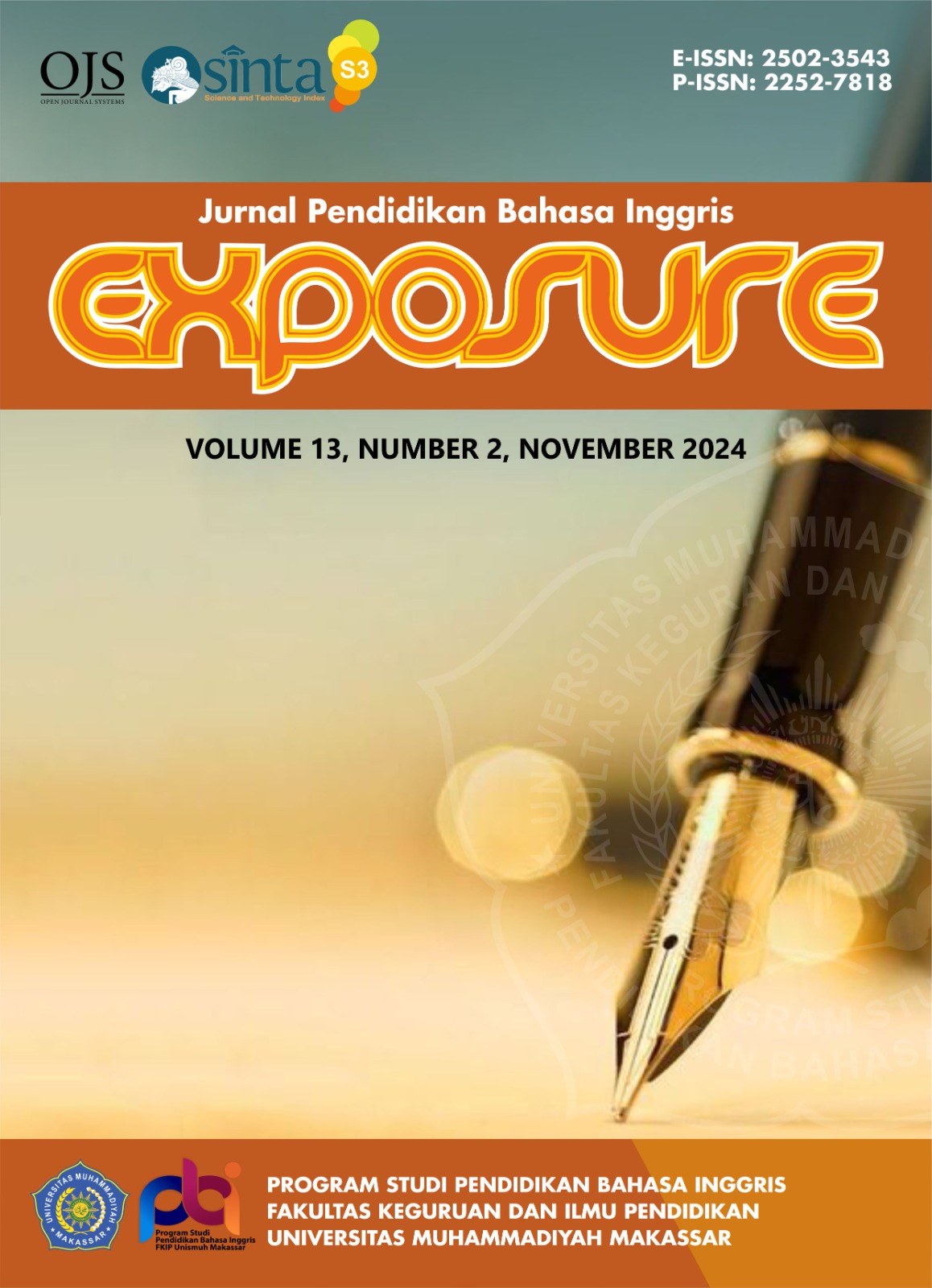TABOO WORDS IN JAVANESE SPOKEN IN PANEKAN VILLAGE, MAGETAN, EAST JAVA
DOI:
https://doi.org/10.26618/exposure.v13i2.14195Keywords:
taboo word, Javanese language, Tri Hita KaranaAbstract
This research aims to identify taboo words, taboo forms, and their taboo references This study was designed in the form of a descriptive qualitative research which involved two types of data: primary and secondary. The researchers acted as the main instuments in this study. The other instrument interview guide, smartphone, and notebook. The source of data were the 3 informants selected based on a set of criteria. The identified data were analyzed as follows: the data of taboo words were analyzed into 3 domains in the concept of Tri Hita Karana. The data related to taboo form were analyzed using Frazer’s (1955) and Montagu’s theory (1973), and the data related to their referances of taboo words were analyzed using Frazer’s (1955) theory.The results of this study show that there were 44 taboo words were found and connected to the three domains of Tri Hita Karana concept. 3 related Parahyangan, 37 related to Pawongan, and 5 related to Palemahan. The 40 among 44 taboo words were classified into swearing words. 4 among the 44 taboo words identified were classified into taboo names . From the 44 taboo words were found 11 types of refrences: parent’s names (3), animal’s name (4), mentioning genital (5), sexual activity (4), wisdom of ruler (1), bodily function (6), nature (1), illness (9), name of spirit (1), personal pronouns (5), and spesific activity (5), were found.
.
References
Amano, T., Sandel, B., Eager, H., Bulteau, E., Svenning, J. C., Dalsgaard, B., Rahbek, C., Davies, R. G., & Sutherland, W. J. (2014). Global distribution and drivers of language extinction risk.
Proceedings of the Royal Society B: Biological Sciences, 281(1793). https://doi.org/10.1098/rspb.2014.1574
Atifnigar, H., Assistant, T., Safari, M. Z., & Rafat, A. H. (2021). Exploring the Causes of Language Death: A Review Paper Teaching Assistant Teaching Assistant. In Article in International Journal of Humanities and Social Science (Vol. 4). https://www.researchgate.net/publication/353767282
Ayu Febriyani, P., & Tira Erlangga, D. (2023). THE RELATIONSHIP BETWEEN CULTURE AND LANGUAGE (Vol. 3, Issue 1).
Dewi, K., Budasi, G., Ramendra, D. P., Pendidikan, J., Inggris, B., Bahasa, F., & Seni, D. (2017). AN ANALYSIS OF BALINESE SWEAR WORDS USED IN CEMPAGA VILLAGE.
Gao, C. (2013). A sociolinguistic study of English Taboo language. Theory and Practice in Language Studies, 3(12), 2310–2314. https://doi.org/10.4304/tpls.3.12.2310-2314
Homai, Y., & Torabi, M. (n.d.). Language Endangerment, Language Death and its Factors. https://doi.org/10.47814/ijssrr.v6i10.1720
Peticca-Harris, A., deGama, N., & Elias, S. R. S. T. A. (2016). A Dynamic Process Model for Finding Informants and Gaining Access in Qualitative Research. Organizational Research Methods, 19(3), 376–401. https://doi.org/10.1177/1094428116629218
Suzanne Abdulhadi, A., Abd Al-Zahrra Hamza, H., & Author, C. (2023). Eastern Journal of Languages, Linguistics and Literatures (EJLLL) A Sociolinguistic Analysis of Selected Taboo Words in English and Arabic. https://www.qabasjournals.com/index.php/ejlll
Sagatova, M. (2022). The Relationship between a Language and Culture. In International Journal on Integrated Education (Vol. 5, Issue 1).
Yuliandari, Maharudinsah, Selamat Husni Hasibuan, & Rhendivan Pasaribu. (2024). Bentuk-Bentuk Bahasa Tabu pada Masyarakat di Desa Muara Batu-Batu. LITERATUR : Jurnal Bahasa Dan Sastra, 6(1), 1–34. https://doi.org/10.47766/literatur.v6i1.2577
Zuindra, Z., Pujiono, Mhd., & Arifuddin, A. (2021). TABOO WORDS IN DELI JAVANESE DIALECT. Language Literacy: Journal of Linguistics, Literature, and Language Teaching, 5(2), 535–541. https://doi.org/10.30743/ll.v5i2.4562
Downloads
Published
Issue
Section
License
Authors who publish with this journal agree to the following terms:
In order to assure the highest standards for published articles, a peer review policy is applied. In pursue of the compliance with academic standards, all parties involved in the publishing process (the authors, the editors and the editorial board and the reviewers) agree to meet the responsibilities stated below in accordance to the Journal publication ethics and malpractice statement.
Duties of Authors:
- The author(s) warrant that the submitted article is an original work, which has not been previously published, and that they have obtained an agreement from any co-author(s) prior to the manuscript’s submission;
- The author(s) should not submit articles describing essentially the same research to more than one journal;
- The authors(s) make certain that the manuscript meets the terms of the Manuscript Submission Guideline regarding appropriate academic citation and that no copyright infringement occurs;
- The authors(s) should inform the editors about any conflict of interests and report any errors they subsequently, discover in their manuscript.
Duties of Editors and the Editorial Board:
- The editors, together with the editorial board, are responsible for deciding upon the publication or rejection of the submitted manuscripts based only on their originality, significance, and relevance to the domains of the journal;
- The editors evaluate the manuscripts compliance with academic criteria, the domains of the journal and the guidelines;
- The editors must at all times respect the confidentiality of any information pertaining to the submitted manuscripts;
- The editors assign the review of each manuscript to two reviewers chosen according to their domains of expertise. The editors must take into account any conflict of interest reported by the authors and the reviewers.
- The editors must ensure that the comments and recommendations of the reviewers are sent to the author(s) in due time and that the manuscripts are returned to the editors, who take the final decision to publish them or not.
Authors are permitted and encouraged to post online a pre-publication manuscript (but not the Publisher’s final formatted PDF version of the Work) in institutional repositories or on their Websites prior to and during the submission process, as it can lead to productive exchanges, as well as earlier and greater citation of published work (see The Effect of Open Access). Any such posting made before acceptance and publication of the Work shall be updated upon publication to include a reference to the Publisher-assigned DOI (Digital Object Identifier) and a link to the online abstract for the final published Work in the Journal.

